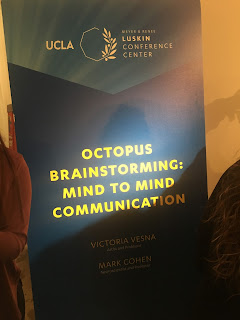Week 1: Two Cultures
 The idea that there is a lack of appreciation and comradery found between these two cultures leaves me bewildered. When V. Vesna brings up the idea that “any working relationship needs to be based on mutual respect and dialogue," I instantly thought of all that had been accomplished in the world due to this very idea. If people only thought in one dimension and never unified the cultures, a lot of what we see today would perhaps just be a mere "what if".
The idea that there is a lack of appreciation and comradery found between these two cultures leaves me bewildered. When V. Vesna brings up the idea that “any working relationship needs to be based on mutual respect and dialogue," I instantly thought of all that had been accomplished in the world due to this very idea. If people only thought in one dimension and never unified the cultures, a lot of what we see today would perhaps just be a mere "what if".Would Aristotle's discoveries in both science and art be seen today? If Leonardo Da Vinci was one dimensional, what would go? His timeless arts, such as the "Mona Lisa" and "Last Supper," or all of his scientific contributions, such as his early designs for helicopters and flying machines?
Bridging this gap between the arts and sciences answers that "what if" question and fulfills that sense of wonder. Some of the most brilliant minds saw the potential and opportunities in unifying both cultures. As a result, the best inventions of human civilization have been seen due to the notion that these cultures could and should help and benefit from one another.
This separation is even depicted at UCLA with North Campus being for those who study the arts and social sciences while South Campus being for those who study mathematics and the sciences. Nevertheless, the separation of cultures presented on UCLA should not stop individuals from pursuing to learn about these two cultures. I understand why there seems to be a need for separation between the arts and sciences; however, I hope that the human civilization as a whole never concedes to the simplicity and rigidness that there is simply no way both the arts and sciences can live cohesively.
 Reading Snow’s paper about how the cultural divide in England is solidified through the country’s belief in educational specialization and crystallization of social forms scares me. I believe now, more important than ever, that we should never frown upon one another and instead should support one another to fulfill all the opportunities presented by the arts and sciences.
Reading Snow’s paper about how the cultural divide in England is solidified through the country’s belief in educational specialization and crystallization of social forms scares me. I believe now, more important than ever, that we should never frown upon one another and instead should support one another to fulfill all the opportunities presented by the arts and sciences.
For me, I am pursuing a double major in political science and psychology. I welcome this third culture with arms open wide as I am entering the world of psychology, where the sciences and arts are combined. At the end of the day, I never want to say what if and I want to always be creative and never limit my opportunity to learn.
Snow, C.P. The Two Cultures: And a Second Look. N.p.: n.p., 1963. Print.
Vesna, Victoria. "Toward a Third Culture: Being In Between." Leonardo. 34 (2001): 121-125. Print.
 Reading Snow’s paper about how the cultural divide in England is solidified through the country’s belief in educational specialization and crystallization of social forms scares me. I believe now, more important than ever, that we should never frown upon one another and instead should support one another to fulfill all the opportunities presented by the arts and sciences.
Reading Snow’s paper about how the cultural divide in England is solidified through the country’s belief in educational specialization and crystallization of social forms scares me. I believe now, more important than ever, that we should never frown upon one another and instead should support one another to fulfill all the opportunities presented by the arts and sciences. For me, I am pursuing a double major in political science and psychology. I welcome this third culture with arms open wide as I am entering the world of psychology, where the sciences and arts are combined. At the end of the day, I never want to say what if and I want to always be creative and never limit my opportunity to learn.
Sources
Snow, C. P. “Two Cultures and the Scientific Revolution.” Reading. 1959. New York: Cambridge UP, 1961. Print.
Snow, C. P. “Two Cultures and the Scientific Revolution.” Reading. 1959. New York: Cambridge UP, 1961. Print.
"Mona Lisa." Wikipedia. Wikimedia Foundation, 06 Apr. 2017. Web. 09 Apr. 2017.
"Psychiatry." Pinterest. N.p., n.d. Web. 09 Apr. 2017.
Rsickler. "Music 02 – Defining the Art." 121m. N.p., n.d. Web. 09 Apr. 2017.
Snow, C.P. The Two Cultures: And a Second Look. N.p.: n.p., 1963. Print.
Vesna, Victoria. "Toward a Third Culture: Being In Between." Leonardo. 34 (2001): 121-125. Print.




Comments
Post a Comment